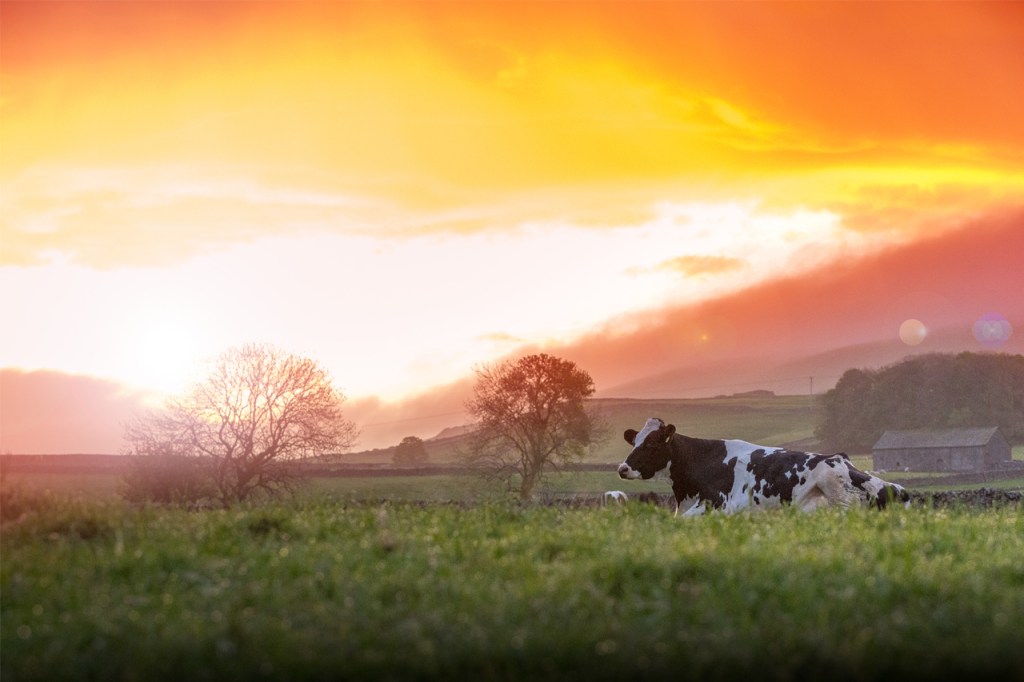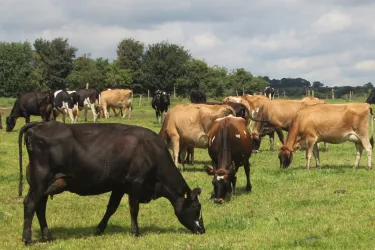In the hotter months of Summer many dairy enterprises will be considering how to prevent or reduce the effects of heat stress on milk production and reproductive efficiency.
In the Summer of 2018 many herds experienced milk loss and experienced poor reproduction. Not only in conception rates within the milking herd at the time, but the ongoing effects of poor 1st service conception rates for a number of months thereafter due to the effects of heat stress on cows that were dry during those .
Heat stress occurs when a cow’s heat load exceeds her capacity to dissipate heat.
Cows affected by heat stress will redirect blood to the skin and away from internal organs. This is to assist with evaporative heat loss, increase their respiratory rate and in some cases pant, have reduced lying times, reduced dry matter intake and subsequently have reduced milk yields and impaired reproduction.
The degree of heat stress exposure for dairy cattle is considered as a temperature humidity index (THI).
At a THI of 68 a cow’s stress threshold is reached this would be the equivalent of 45% relative humidity with temperatures as low as 22°C.
At this point cows could be found with respiratory rates at 60 breaths per minute, milk loss beginning at ~1kg/cow/day and deleterious effects on reproduction already occurring.
It’s important to note that people may not feel heat stress until 26°C and 40% humidity – a THI of 80.
Methods for Reducing Heat Stress include:
Providing shade
It’s one of the most easily implemented and economical methods of minimising heat from solar radiation.
However it will not alter air temperature or relative humidity around cows to maximise evaporative cooling of cows.
This should be born in mind if considering housing by day for shade and grazing at night.
Dairy systems where cows are grazed during the day should consider availability of shade, particularly where dry cows may be grazed in summer, e.g. the value of shading under trees should not be underestimated.
High stocking densities within buildings
This can be a bottleneck to reducing heat stress. E.g. within a 3 row cubicle barn to feed face cows will have approximately 45cm per cow compared to 73cm per cow within a 2 row barn at 100% stocking density.
At 120% stocking density 3 row barns will only have on average 38cm per cow compared to 61cm per cow in a 2 row barn. Space is key at times when cows may be at risk of heat stress.
Water availability
This is critical, recommendations are based on 10 linear centimetres per cow with ideally a minimum of 2 water troughs per group.
Where water pressure is not an issue, shallow tipping water troughs are easy to keep clean. However, where farm water pressure is low, larger deep water troughs should be considered.
A minimum depth of 7.5cm of water is recommended.
Air movement
Fans are often installed to improve air movement through buildings to increase convective heat loss in cattle. These are most effective when combined with sprinkler systems to improve evaporative cooling.
Specialist advice should be sought when installing fan based cooling systems with or without sprinkler systems as efficiencies of different fans varies widely.
As a general rule of thumb – low volume, high velocity type fans should be placed over feedlines and stalls. Spacing between fans should not be more than 10 times the diameter of the fan with some recommendations suggest 5 times the diameter of the fan and be pitched downwards to aim their airflow at a point directly below the next fan in line.
Fans ideally should be automated for on/off times, remember people are more tolerant of heat and humidity than cows. And cooling should extend to the later parts of the day as these are often when cows are experiencing peak heat stress due to thermal loading throughout the day.
Cooling systems in the collection yard or holding pens, where stocking densities are at their highest, are critical, particularly if milking times occur in the afternoon. Ideally cows should not be packed tightly with the backing gate during periods of risk of heat stress.
Feeding strategy
Feeding strategies to discuss with ruminant nutritionists include reducing fermentable energy in the ration by using rumen inert fats as a partial substitute for starch.
Rumen degradable protein could be reduced and rumen undegradable protein maximised to account for reduced starch in the ration.
Slowly shifting feeding times to deliver fresh feed very early in the morning and/ or late at night.
Monitoring dry matter intakes particularly in transition and fresh cow groups is critical and especially during times of heat stress. This is to reduce the risk of retained foetal membranes, metritis, endometritis (whites) and poor 1st service conception rates.
In summary provision of shade, water, space, and cooling of cows through air movement and sprinkler systems are key aspects to consider on your dairy farm at times when cows may be at risk of heat stress.
Consult with your vet, nutritionist and breeding advisor to understand the risks of heat stress within your herd this Summer – particularly if you’ve switched on the air conditioning in your cab already.
By Jon Mouncey, Farming Life.
If you’re interested in learning more about dairy fertility, visit our website for more information.






